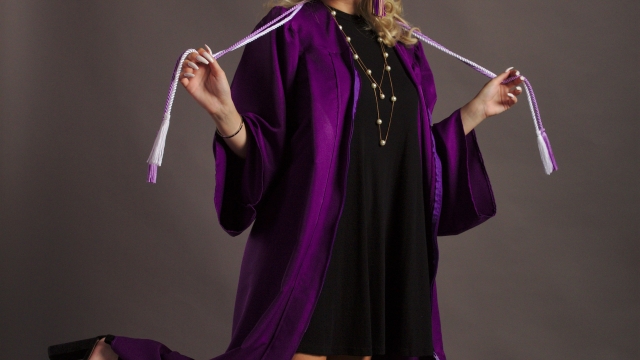
Dressed for Success: The Symbolism of Caps and Gowns

Caps and gowns hold a special place in the hearts of many, as they signify achievement, growth, and the journey towards success. Whether it’s an adorable preschool cap and gown or an elegant master degree ensemble, these iconic attires are much more than mere clothing. They symbolize not only the completion of a stage in one’s education, but also the beginning of a new chapter filled with possibilities and opportunities. They act as a visual reminder of the hard work, dedication, and perseverance that have led to this significant milestone.
The tradition of wearing caps and gowns can be traced back to ancient times when scholars and clergy members would wear them as a sign of their intellectual prowess. Throughout history, this sartorial tradition has evolved, with each educational level having its distinctive style and colors. From the youthful innocence represented by the pint-sized graduates donning preschool caps and gowns to the sophistication embodied by those earning esteemed master degrees, these garments reflect both personal achievements and the prestige associated with higher education.
Regardless of the level of education achieved, the wearing of caps and gowns unifies and brings a sense of equality among graduates. It creates a sense of camaraderie, allowing individuals from various backgrounds and areas of study to come together and share in the celebration of their accomplishments. The shared experience of donning these garments becomes a visible testament to the power of education and the transformative impact it has on individuals and societies as a whole.
So, whether you’re adorned in a precious preschool cap and gown or a distinguished master degree ensemble, these ceremonial attires are not just simple garments. They are powerful symbols that encapsulate the journey, the efforts, and the dreams that have culminated in a moment of triumph and new beginnings. They remind us all that dressing for success goes beyond fashion; it is a tangible representation of personal growth, knowledge, and the pursuit of excellence.
The Significance of Preschool Cap and Gown
Preschool graduation ceremonies are a cherished tradition that celebrates a child’s early educational milestones. One of the most visually striking aspects of these ceremonies is the donning of the preschool cap and gown. These pint-sized academic outfits hold great symbolism, signifying a child’s transition from early childhood to the beginning of their educational journey.
The preschool cap and gown act as a visual representation of the child’s growth and achievements during their time in preschool. By wearing these traditional garments, young graduates are being recognized for their hard work, dedication, and successful completion of the preschool program.
Furthermore, the act of wearing a cap and gown fosters a sense of pride and accomplishment in the preschoolers. These tiny graduates get to experience a taste of what lies ahead in their educational pursuits, creating a sense of anticipation and excitement for their future academic endeavors.
Overall, the preschool cap and gown hold immense significance in the lives of young children. They symbolize not just the end of a preschool chapter, but the beginning of a new one filled with learning, growth, and endless possibilities.
The Symbolism Behind Master Degree Caps and Gowns
The cap and gown worn during master degree graduation ceremonies hold a significant symbolism that reflects the achievement and culmination of years of dedication and hard work. These traditional academic garments, made up of a cap, gown, and hood, represent the highest level of academic accomplishment and mark the transition from student to scholar.
The cap, often referred to as a mortarboard, is a recognizable symbol of graduation. Its square shape, with a flat top and tassel, has historical origins dating back to the Middle Ages. The tassel, originally worn by scholars to keep their hoods in place, has since become a symbol of achievement. During the graduation ceremony, the tassel is typically worn on the right side of the cap and moved to the left side once the degrees are conferred, signifying the completion of the academic journey.
The gown, usually black in color, is a representation of the long-standing academic traditions. Its design originated from the robes worn by medieval scholars and clergymen, as a way to signify their educated status. The flowing nature of the gown contributes to the sense of grandeur and formality associated with the master degree ceremony, while also serving as a unifying element, reflecting the camaraderie among graduates.
The hood, often the most colorful and ornate part of the ensemble, is a distinctive feature of master degree caps and gowns. The hood’s colors and design symbolize the graduate’s field of study and academic achievements. The length, lining, and specific colors within the hood are determined by the graduate’s discipline, degree level, and university’s traditions. The hood serves as a visual representation of the graduate’s expertise and scholarly accomplishments and holds great meaning during the graduation ceremony.
In conclusion, the cap and gown worn during master degree graduation ceremonies are rich in symbolism. From the cap with its tassel movement, to the elegant gown, and the vibrant hood, each element represents the culmination of a challenging academic journey and the transition into the realm of higher education and expertise.
Implications of Caps and Gowns for Academic Achievement
Caps and gowns hold significant symbolism when it comes to academic achievement. Whether it’s the adorable preschool cap and gown or the distinguished master’s degree attire, these garments play a role in shaping our perception of educational accomplishments.
Firstly, the sight of youngsters in their tiny preschool caps and gowns evokes a sense of pride and accomplishment. These miniature ensembles signify the culmination of a foundational education journey. They serve as a visual representation of the early academic milestones achieved by these young learners, instilling in them a sense of achievement and motivation to continue on their educational path.
Kindergarten Graduation Caps And Gowns
Moving on to the realm of higher education, master’s degree caps and gowns are steeped in tradition and prestige. Donning these regalia, students embody the culmination of years of rigorous study and specialization. The elaborate nature of these outfits showcases the dedication and hard work put forth by individuals pursuing advanced degrees. It is a visual manifestation of their commitment to expanding knowledge in their chosen field of expertise.
Moreover, the symbolism of caps and gowns extends beyond the individual level. They also hold a symbolic significance for the larger academic community. Seeing a sea of students adorned in their respective graduation attire creates a sense of unity and shared accomplishment. It represents the collective efforts of students, faculty, and institutions in fostering an atmosphere conducive to learning and growth.
In conclusion, caps and gowns carry a profound symbolism when it comes to academic achievement. From the cute preschool graduation outfits to the distinguished master’s regalia, these garments not only celebrate personal milestones but also serve as a visual representation of the broader value and impact of education.



